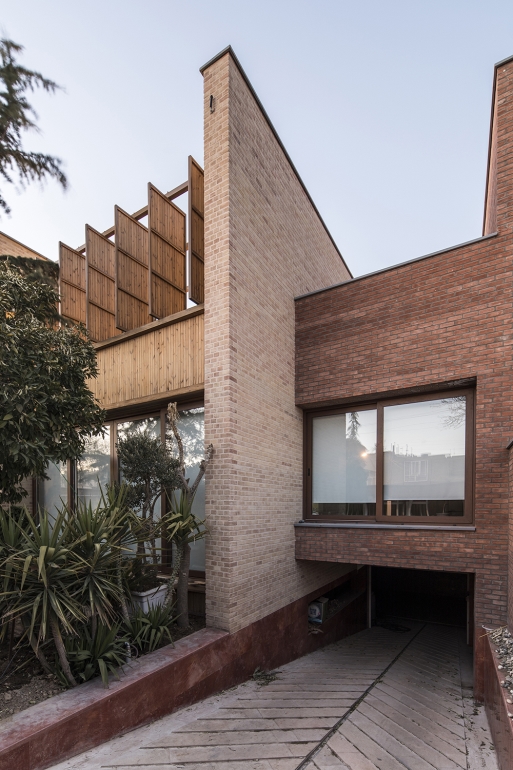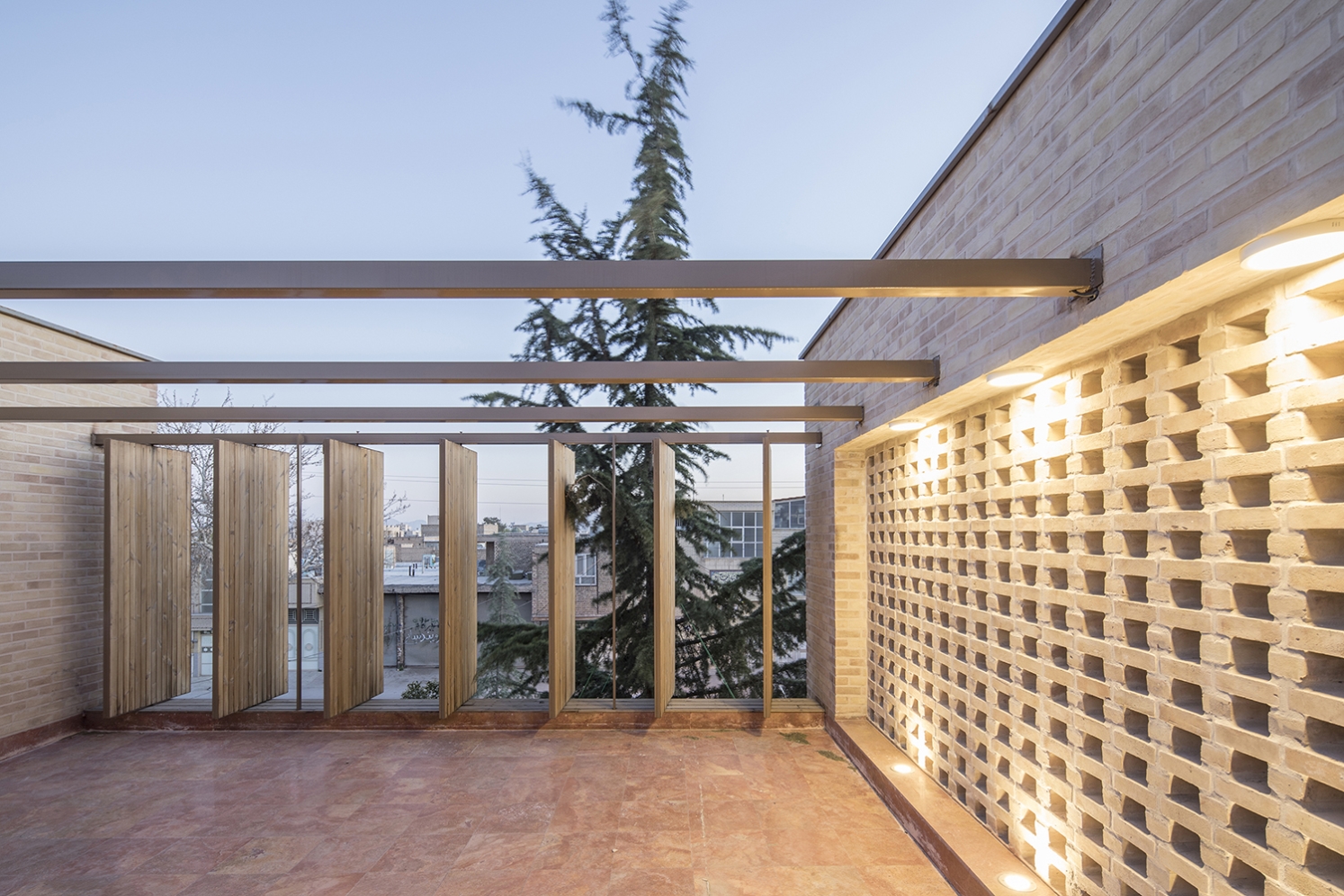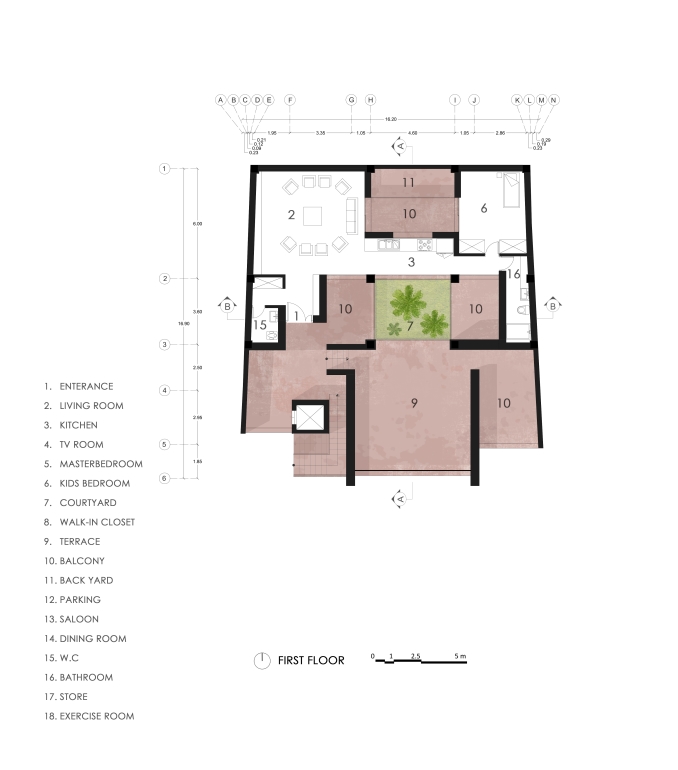
Location: Iran, Najafabad
Completion Year: 2019
Area: 600 m2
Lead Architects: Ali Soltani, Atefeh Karbasi, Ali Dehghani, Behnam Emami
Other participants: Nastaran Sedehi
Clients: Ebrahim Salehi
Photo credits: Farshid Nasrabadi
This project aimed to design a house for a family of four in Najafabad. The family's interest in having open space with lush gardens, along with the historical pattern of houses in Najafabad's garden city, made the main decision of this project: to give all spaces the great advantage of having a yard in the middle. In addition to the middle yard, there is another yard on the south, which is considered obligatory by the municipality. There is also another small yard on the north of the land for private use.
The numerous numbers of yards and their diverse nature make it possible for indoor spaces to benefit from outdoor or indoor yards. The house is designed in three floors; the ground floor for family life, the first floor for the accommodation of guests, and the basement for the car park, storage, and gym.
Next to the entrance on the ground floor, which is accessible from the southern yard, lies the staircase and the elevator that provide separate access to the first floor for guests. On the ground floor, the middle yard is located in the center of the house to create maximum view and connection between spaces. The guest hall, as the largest space, is located between the inner yard and the southern yard. The kitchen, on the west of the middle yard, is connected to the public and private areas of the house. Private spaces, including seating room and bedrooms, are on the north of the house. The middle yard provides not only light and green space for them, but also separates the private space from the public area.
The first floor consists of a suite for guests and a terrace. The volume of the building on this floor is positioned on the northern end of the land and the terrace is located between the middle yard and the southern yard. The east and the west sides of the middle yard on the first floor are the private and public balconies of the guest suite. Therefore, the south, east, and west sides of the yard on the first floor are open, which in turn causes the middle yard to take great advantage of sunlight. A movable timber wall on the south façade of the terrace provides privacy on some occasions.
Brick, as one of the vernacular materials, has been used in the façade. The red brick and the green plants of the yards have given the house a pleasant contrast. The eastern and western walls of the guest hall and the terrace, which are located in the heart of the house, are distinguished by the cream-colored bricks in the façade and are seen between the external red walls.
Now this house in a city, which once was a garden city during the Safavid era, stands as a symbol of life filled with nature in the historical houses. Trees and plants have ripped apart the whole construction site and risen to revive the experience of living among trees and yards for the current residents.
Location: Iran, Najafabad
Completion Year: 2019
Area: 600 m2
Lead Architects: Ali Soltani, Atefeh Karbasi, Ali Dehghani, Behnam Emami
Other participants: Nastaran Sedehi
Clients: Ebrahim Salehi
Photo credits: Farshid Nasrabadi

This project aimed to design a house for a family of four in Najafabad. The family's interest in having open space with lush gardens, along with the historical pattern of houses in Najafabad's garden city, made the main decision of this project: to give all spaces the great advantage of having a yard in the middle. In addition to the middle yard, there is another yard on the south, which is considered obligatory by the municipality. There is also another small yard on the north of the land for private use.
The numerous numbers of yards and their diverse nature make it possible for indoor spaces to benefit from outdoor or indoor yards. The house is designed in three floors; the ground floor for family life, the first floor for the accommodation of guests, and the basement for the car park, storage, and gym.
Next to the entrance on the ground floor, which is accessible from the southern yard, lies the staircase and the elevator that provide separate access to the first floor for guests. On the ground floor, the middle yard is located in the center of the house to create maximum view and connection between spaces. The guest hall, as the largest space, is located between the inner yard and the southern yard. The kitchen, on the west of the middle yard, is connected to the public and private areas of the house. Private spaces, including seating room and bedrooms, are on the north of the house. The middle yard provides not only light and green space for them, but also separates the private space from the public area.
The first floor consists of a suite for guests and a terrace. The volume of the building on this floor is positioned on the northern end of the land and the terrace is located between the middle yard and the southern yard. The east and the west sides of the middle yard on the first floor are the private and public balconies of the guest suite. Therefore, the south, east, and west sides of the yard on the first floor are open, which in turn causes the middle yard to take great advantage of sunlight. A movable timber wall on the south façade of the terrace provides privacy on some occasions.
Brick, as one of the vernacular materials, has been used in the façade. The red brick and the green plants of the yards have given the house a pleasant contrast. The eastern and western walls of the guest hall and the terrace, which are located in the heart of the house, are distinguished by the cream-colored bricks in the façade and are seen between the external red walls.
Now this house in a city, which once was a garden city during the Safavid era, stands as a symbol of life filled with nature in the historical houses. Trees and plants have ripped apart the whole construction site and risen to revive the experience of living among trees and yards for the current residents.





























